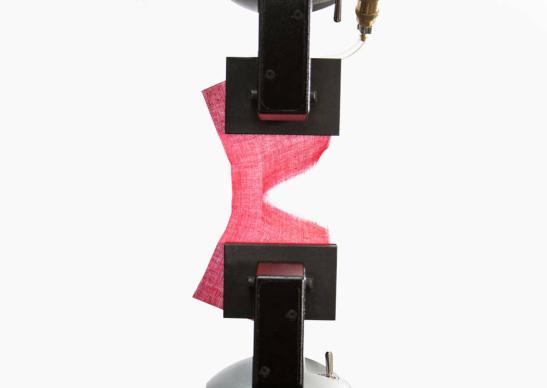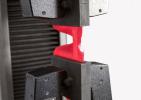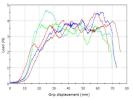ISO 9073-4 Tear Resistance Nonwovens
This standard specifies a procedure to determine the tear force of nonwoven textile fabrics using the trapezoid method. A rectangular specimen is marked and prepared so that it can be loaded in the grip faces at an angle, allowing a tear to propagate across the specimen.
For this test, it is important to have an increased test data rate to ensure the capture a high number of data points. This is because when individual fibers within the fabric fail, the data rate must be fast enough to catch these peaks.
Pneumatic side action grips with rubber coated jaw faces are well suited for clamping of the trapezoid specimens. While manual action grips will work, many prefer pneumatic side action grips for ease of use, productivity, and better repeatability. Adjustable grip pressure also allows users to fine-tune the gripping pressure to avoid jaw breaks or slippage.
The challenges of testing to this standard are:
- Rapid data capture rate
- Specimen gripping
Instron's Solution:
- Rapid data capture rate with Instron's 5900 controller allows data peaks and valleys to be captured accurately at up to 2,500 points per second
- Instron pneumatic side action grips with rubber faces are well-suited to gripping nearly all types of fabric specimens for this test while maintaining high throughput
It is important to review ISO 9073-4:1997 in order to fully understand the test setup, procedure, and results requirements.
2712-04X Series Pneumatic Side-Action Grips
Pneumatic side-action grips offer a versatile gripping solution for a wide range of materials. Rated capacities between 1 and 10 kN.
- Products
- 03/22/2022
- 1.13 MB
2710 Series Screw Side Action Grips
Screw side-action grips provide a very simple and efficient method for holding test specimens in a wide range of applications. The dual – acting design of 2710-100 series grips means that jaw faces can be adjusted to accommodate different specimen thicknesses. This ensures that the line of tensile force remains concentric with the grip body. They can be equipped with a selection of interchangeable grip jaw faces in various sizes and choice of surfaces including smooth ground, rubber-coated and serrated. Line contact and special coated faces are also available.The unique ‘snap-on’ jaw face attachment makes changing faces extremely quick and simple.
- Products
- 06/28/2017
- 1.29 MB
6800 Series Premier Testing Systems Brochure
Instron 6800 Series Universal Testing Systems provide unparalleled accuracy and reliability. Built on a patent-pending Operator Protect system architecture with an all-new Smart-Close Air Kit and Collision Mitigation features, the 6800 Series makes materials testing simpler, smarter, and safer than ever before.
- Products
- 02/10/2020
- 1.93 MB
3400 Series Universal Testing Systems Brochure
Instron 3400 Series universal testing systems for tensile, compression, bend, and other material property tests.
- Products
- 06/27/2022
- 2.69 MB
Bluehill Universal Brochure
Bluehill Universal is Instron’s advanced materials testing software, designed for intuitive touch interaction and streamlined workflows. It offers pre-loaded test methods, QuickTest for rapid setup, enhanced data exporting, and Instron Connect for direct service communication. Users of Bluehill 2 and Bluehill 3 can easily upgrade to the latest version for improved performance and usability
- Products
- 02/26/2017
- 3.77 MB



